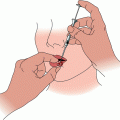Type
Sources & synonyms
Type of generator
kV
D ½ (mm tissue)
Surface dose (%)a
Megavoltage electron therapy
Electron beam radiation
Linear accelerator (LINAC)
>1,000 (6,000–9,000)
90 % Isodose method used for electronsb
78–86
Megavoltage photon therapy (not routinely used to treat NMSC)
Megavoltage X-ray
Linear accelerator (LINAC)
>1,000
150–200
6–30
Supervoltage therapy
Gamma (γ)-ray
Isotope teletherapy machines (60Cobalt)
>1,000
80–110
40–90
Orthovoltage therapy
Deep X-ray
X-ray machine
200–400
50–80
100
Intermediate therapy
Half-deep therapy
X-ray machine
110–130
30
100
Superficial/soft X-ray therapyc
Pyrex (glass) window (older units), Beryllium window (modern units)
X-ray machine
20–100
1–20
100
Grenz therapy
Ultrasoft therapy, Supersoft therapy
X-ray machine
5–20
0.2–0.8
100
General Indications for Superficial Radiotherapy of BCC/SCC
1.
Location of the skin cancer in the central face, including the eyelids, nasal tip, nasal ala, ears, the lips, and in patients with rhinophyma where surgical extirpation leaves complex skin/cartilage defects and surgical repair leaves a noticeable scar. Advantages of SRT in these areas are the tissue sparing effect, with retention of pretreatment function as well as preservation of these cosmetically sensitive facial aesthetic units. SRT is considered less advantageous on the trunk and even less so on the extremities due to late-sequelae changes (telangiectasias and pigmentary changes), lower oxygen saturation leading to wound healing issues, and the general ease and expediency of surgical removal.
2.
Older age. To minimize the synergistic effects of ultraviolet radiation, superficial radiation should not be considered in patients younger than 60 years of age [12]. In our practice the age of patients considered for SRT is 65 years of age and above and our median patient age is 78.
3.
Tumor size. Medium size tumors up to 5 cm in diameter may be adequately treated with SRT. Tumors larger than 5 cm treated with SRT demonstrate higher recurrence rates [13, 14], and may be best treated with Mohs surgery or at tertiary centers where imaging and complex treatment planning (hyperfractionation schedules) and multiple modalities are available to the patient.
4.
Tumor type/depth of invasion. Superficial and nodular BCCs, SCCIS, and SCC that are nonaggressive are amenable to SRT. We and others before us avoid SRT for aggressive BCCs (sclerosing, morpheaform, infiltrative) [15, 16]. SCCs with aggressive features such as poorly/undifferentiated, spindle cell, sarcomatous, deeply invasive, or those exhibiting perineural invasion should, whenever possible, be approached with Mohs surgery with consideration of postoperative radiotherapy to the appropriate depth and field in selected cases [17–21]. Tumors secondary to osteomyelitis arising in previous sites of RT, burn scars, and chronic ulcers are also avoided due to risk of recurrence. SRT is typically not indicated for tumors that invade bone, cartilage.
5.
Frailty and medical status. Patients who are unable to tolerate surgery due to poor health, multiple comorbidities, and who are on anticoagulant therapy. Such patients may incur a higher risk of adverse events with surgery. Eastern Cooperative Oncology Group (ECOG) performance status [22] may be used to document patient functional status and aid decision of radiotherapy vs. surgery (see Table 2). Typically ECOG grades of 2–4 indicate varying degrees of frailty, poor health, or comorbidities associated with a higher risk of adverse events in surgery.
Table 2
Eastern Cooperative Oncology Group (ECOG) performance status
Grade | ECOG |
|---|---|
0 | Fully active, able to carry on all pre-disease performance without restriction |
1 | Restricted in physically strenuous activity but ambulatory and able to carry out work of a light or sedentary nature, e.g., light house work, office work |
2 | Ambulatory and capable of all self-care but unable to carry out any work activities. Up and about more than 50 % of waking hours |
3 | Capable of only limited self-care, confined to bed or chair more than 50 % of waking hours |
4 | Completely disabled. Cannot carry on any self-care. Totally confined to bed or chair |
5 | Dead |
6.
Patient choice. When patients, as part of an informed consent, decide to avoid surgery when radiotherapy is a cost-effective and viable option.
Relative and Absolute Contraindications for Superficial Radiotherapy of BCC/SCC
1.
Aggressive tumor histology. BCC at increased risk for recurrence include sclerosing, morpheaform, and infiltrative BCC. Aggressive SCC include those with perineural invasion, arising in previous sites of RT, burn scars, chronic ulcers, spindle cell carcinoma, poorly/undifferentiated, or those secondary to osteomyelitis.
2.
Deep tumor invasion. Tumors that invade bone, cartilage, or arise within the mucosal surfaces of the inner nares or intraorally. However, these may be treated successfully using other radiation methods capable of penetrating deeper (orthovoltage, megavoltage photon, megavoltage electron beam radiation) or capable of delivering the radiation dose specifically to the tumor bypassing healthy tissue (intensity modulated radiation therapy) [19, 23].
3.






